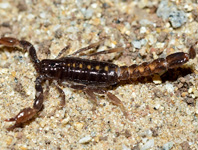Abstract
A comparative study of over 1,000 specimens allowed us to revise the taxonomy of the Amazonian butterfly genus Bia. We redescribed the genus, and used a selected set of characters to define and describe new species and subspecific taxa. We found that male genitalia showed little variation among taxa, and that wing and genitalia characters varied independently across the range of the genus. We also noted that species diversification seems to follow a north-south Amazonian divide, with Bia actorion and decaerulea occupying the northern portion of the genus range while the remaining four species are found in southern Amazonia. As defined here Bia includes six species: B. actorion (Linnaeus), B. actorion ecuatoria DeVries & Penz, NEW SSP., B. actorion occulta Casagrande & Penz, NEW SSP., B. decaerulea Weymer STAT. NOV., B. decaerulea cayana Simonsen & Penz, NEW SSP., B. decaerulea pallida Casagrande & Penz, NEW SSP., B. rebeli Bryk STAT. NOV., B. rebeli aegina Penz & Simonsen, NEW SSP., B. rebeli acreana Casagrande & Penz, NEW SSP., B. rebeli arikeme Penz & Casagrande, NEW SSP., B. rebeli pareci Penz & DeVries, NEW SSP., B. rebeli cuprea Penz & Casagrande, NEW SSP., B. rebeli tapajos Penz & Simonsen, NEW SSP., B. caelestis Penz & DeVries, NEW SP., B. pucallpa Casagrande & Penz, NEW SP., and B. peruana Röber.
References
Abbott, R., Albach, D., Ansell, S., Arntzen, J.W., Baird, S.J., Bierne, N., Boughman, J., Brelsford, A., Buerkle, C.A., Buggs, R., Butlin, R.K., Dieckmann, U., Eroukhmanoff, F., Grill, A., Cahan, S.H., Hermansen, J.S., Hewitt, G., Hudson, A.G., Jiggins, C., Jones, J., Keller, B., Marczewski, T., Mallet, J., Martinez-Rodriguez, P., Möst, M., Mullen, S., Nichols, R., Nolte, A.W., Parisod, C., Pfennig, K., Rice, A.M., Ritchie, M.G., Seifert, B., Smadja, C.M., Stelkens, R., Szymura, J.M., Väinölä, R., Wolf, J.B. & Zinner, D. (2013) Hybridization and speciation. Journal of Evolutionary Biology, 26, 229–246.
https://doi.org/10.1111/j.1420-9101.2012.02599.xBlandin, P., Bristow, R., Neild, A., de Souza, J.C., Gareka, Y. & Huertas, B. (2014) Revisiting the Andean butterfly Eryphanis zolvizora group (Lepidoptera, Nymphalidae): one or several species? European Journal of Taxonomy, 71, 1–66.
Bristow, C.R. (1981) A revision of the brassoline genus Catoblepia (Lepidoptera: Rhopalocera). Zoological Journal of the Linnean Society, 72, 117–163.
https://doi.org/10.1111/j.1096-3642.1981.tb01655.xCasagrande, M.M. (1995) Notas sistemáticas sobre Brassolinae. I. Tribos (Lepidoptera, Nymphalidae). Revista Brasileira de Zoologia, 12, 671–699.
https://doi.org/10.1590/S0101-81751995000300023Casagrande, M.M. (2002) Naropini Stichel, taxonomia e imaturos (Lepidoptera, Nymphalidae, Brassolinae). Revista brasileira de Zoologia, 19, 467–569.
https://doi.org/10.1590/S0101-81752002000200012Clerck, C.A. (1759–1764) Icones insectorum rariorum cum nominibus eorum trivialibus, locisque a C. Linnaei Arch: R: et Equ: Aur: Syst: Nat: allegatis. Vol. 1. & 2. Litems Laur. Aalvii, Holmiae, 12 pp., 16 pls. & 18 pp. + 39 pls. [Vol. 1: [12] pp., pls. 1–16 (1759); Vol. 2: [8] + [3] pp., pls. 17–55 + [7] ([1764]).]
Figueiredo, J., Hoorn, C., Van der Ven, P. & Soares, E. (2009) Late Miocene onset of the Amazon Rive and the Amazon deep-sea fan: Evidence from the Foz do Amazonas Basin. Geology, 37, 619–622.
https://doi.org/10.1130/G25567A.1Freitas, A.V.L. & Brown Jr., K.S. (2004) Phylogeny of the Nymphalidae (Lepidoptera). Systematic Biology, 53, 363–383.
https://doi.org/10.1080/10635150490445670Hemming, A.F. (1964) Annotationes lepidopterologicae. Vol. 5. Hepburn & Sons Ltd, London, 27 pp. [pp. 153–180]
Kristensen, N. (2003) Skeleton and muscles: adults. In: Kristensen, N. (Ed.), Lepidoptera, Moths and Butterlies. Vol. 2. Morphology Physiology and Development. Walter de Gruyter, Berlin, New York, pp. 39–131
Latrubesse, E.M., Cozzuol, M., da Silva-Caminha, S.A., Rigsby, C.A., Absy, M.L. & Jaramillo, C. (2010) The Late Miocene paleogeography of the Amazon Basin and the evolution of the Amazon River system. Earth-Sci Reviews, 99, 99–124.
https://doi.org/10.1016/j.earscirev.2010.02.005Mallet, J. (1993) Speciation, raciation, and color pattern evolution in Heliconius butterflies: evidence from hybrid zones. In: Harrison, R.G. (Ed.), Hybrid zones and the evolutionary process. Oxford University Press, New York, pp. 226–260.
Nijhout, H.F. (1991) The development and evolution of butterfly wing patterns. Smithsonian Institute Press, Washington, 297 pp.
Penz, C.M. (2007) Evaluating the monophyly and phylogenetic relationships of Brassolini genera (Lepidoptera, Nymphalidae). Systematic Entomology, 32, 668–689.
https://doi.org/10.1111/j.1365-3113.2007.00391.xPenz, C.M. (2008) Phylogenetic revision of Eryphanis Boisduval, with a description of a new species from Ecuador (Lepidoptera, Nymphalidae). Insecta Mundi, 35, 1–25.
Penz, C.M. (2009) The phylogeny of Opoptera butterflies, and an assessment of the systematic position of O. staudingeri (Lepidoptera, Nymphalidae). Zootaxa, 1985, 1–20.
Penz, C.M. & Mohammadi, N. (2013) Wing pattern diversity in Brassolini butterflies (Nymphalidae, Satyrinae). Biota Neotropica, 13 (3), 1–27.
https://doi.org/10.1590/s1676-06032013000300020Penz, C.M., Mohammadi, N. & Wahlberg, N. (2011) Neotropical Blepolenis butterflies: wing pattern elements, phylogeny, and Pleistocene diversification (Lepidoptera, Nymphalidae). Zootaxa, 2897, 1–17.
Penz, C.M., Freitas, A.V.L., Kaminski, L.A., Casagrande, M.M. & DeVries, P.J. (2013) Adult and early-stage characters of Brassolini contain conflicting phylogenetic signal (Lepidoptera, Nymphalidae). Systematic Entomology, 38, 316–333.
https://doi.org/10.1111/syen.12000Penz, C.M., DeVries, P.J., Tufto, J. & Lande, R. (2015) Butterfly dispersal across Amazonia and its implication for biogeography. Ecography, 38, 410–418.
https://doi.org/10.1111/ecog.01172Racheli, L. & Racheli, T. (2004) Patterns of Amazonian area relationships based on raw distributions of papilionid butterflies (Lepidoptera: Papilioninae). Biological Journal of the Linnean Society, 82, 345–357.
https://doi.org/10.1111/j.1095-8312.2004.00363.xSupple, M.A., Hines, H.M., Lavoie, C., Ray, D., Nielsen, D.M., Salazar, C., Dasmahaptara, K., McMillan, W.O. & Counterman, B.A. (2013) Genomic architecture of adaptive color pattern divergence and convergence in Heliconius butterflies. Genome Research, 23(8), 1248–1257.
https://doi.org/10.1101/gr.150615.112Tufto, J., Lande, R., Ringsby, T.-H., Engen, S., Sæther, B-E., Walla, T.R. & DeVries, P.J. (2012) Spatial demography in continuous habitat: estimating dispersal rate, longevity and population density from mark-recapture data. Journal of Animal Ecology, 81, 756–769.
https://doi.org/10.1111/j.1365-2656.2012.01963.xVane-Wright, R.I. & Boppré, M. (2005) Adult morphology and the higher classification of Bia Hübner (Lepidoptera: Nymphalidae). Bonner zoologische Beiträge, 53, 235–254.
Wahlberg, N., Leneveu, J., Kodandaramaiah, U., Peña, C., Nylin, S., Freitas, A.V.L. & Brower, A.V.Z. (2009) Nymphalid butterflies diversify following near demise at the Cretaceous/Tertiary boundary. Proceedings of the Royal Society B, 276, 4295–4302.
https://doi.org/10.1098/rspb.2009.1303Weymer, G. (1911) Family, Satyridae. In: Seitz, A. (Ed.), Die Gross-Schmetterlinge der erde. Vol. 5. Alfred Kernen, Stuttgart, pp. 173–283.
Wootton, R.J. (1979) Function, Homology and terminology in insect wings. Systematic Entomology, 4, 81–93.
https://doi.org/10.1111/j.1365-3113.1979.tb00614.x

